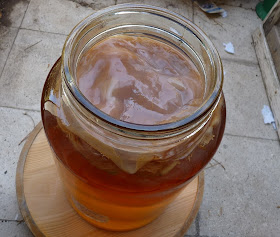
Photo credit: Incase (Flickr)
Spring is here! When spring rolls around, I always seem to get into spring cleaning mode. How about you? If you plan on getting rid of the dust bunnies and clearing out the clutter, you may want to spruce up your pantry, too. Conducting a pantry makeover could be one of the best things that you do for your health and well-being. Stocking up on key kitchen staples will make meal planning and prep much more efficient. Plus, it will make it a lot easier to eat more nutritious meals prepared at home. Even when you have the best of intentions, things don't always go according to plan. However, a well-stocked pantry can help you out of a tough spot rather than having your health thwarted by the local pizza joint or quickest drive-thru more often than not. Here's my list of 10 must-haves for a well-stocked pantry.
{Print this list}
Canned beans (eg, black, kidney, pinto, garbanzo, cannelini): Canned beans pack a lot of plant-based protein, fiber, vitamins, and minerals. Worried about the sodium? Even if you get regular canned beans, draining and rinsing them reduces the sodium content by over 40%. Quick prep ideas: Use in bean soups or salads; Make bean burritos, wraps, or quesadillas; Toss into veggie salads; Mix into whole grain pasta or brown rice.
Whole grains (eg, old-fashioned or steel-cut oats, brown rice, quinoa, bulgur wheat, buckwheat or creamy buckwheat): Grains offer filling fiber along with a variety of vitamins and minerals depending on the grain. Many of those listed can be prepared in less than 30 minutes. Many of these freeze well, so preparing large batches and freezing also saves time. Quick prep ideas: Prepare as a hot breakfast cereal; Enjoy as grain salads, pilafs, and stir fries; Toss into soups and stews.
Nuts, seeds, and nut butters (eg, almonds, walnuts, cashews, pecans, pepitas, sunflower seeds, flaxseeds): Nuts and seeds offer plant-based protein and healthy fats along with a variety of other nutrients, like fiber, vitamin E and magnesium. Quick prep ideas: Enjoy a small handful as a snack; Toss into salads, cooked vegetables, hot breakfast cereals, yogurt, and whole grains, like brown rice or quinoa; Blend into smoothies; Spread nut butters over whole grain breads, tortillas, or pitas and top with fresh fruit; Use nut butters as a dip for raw veggie sticks or fresh fruit.
Tomato products (diced, whole, stewed, crushed, tomato paste, tomato sauce - preferably without added sugar or salt): Tomatoes are a great source of vitamin C, fiber, potassium, and the antioxidant lycopene. Quick prep ideas: Homemade sauces, salsas, soups, stews, and chilis; Add to pasta or grain dishes; Serve as toppings or fillers for pizzas, quesadillas, and sandwiches.
Whole grain and/or gluten-free pasta (eg, spaghetti, penne, linguini, shells, rotini, elbow, couscous): Pasta is fairly quick-cooking, and with so many varieties, it doesn't have to be boring. Whole grain pastas also provide more fiber and naturally-occurring nutrients, like magnesium and iron, than refined versions. Quick prep ideas: Use for traditional pasta dishes dressed with red sauces or olive oil, herbs, and/or spices. Toss in fresh or frozen vegetables for added nutrition; Prepare pasta salads; Work into vegetable soups or stews.
Canned or vacuum-sealed light tuna, salmon, or sardines (in water or olive oil): These protein-rich options are also good sources of omega-3 fatty acids and other nutrients, like vitamin D and selenium. Concerned about sodium? An average serving contains around 180-250 mg of sodium. You can opt for reduced-sodium versions of these products. Limit canned white or albacore tuna, which is higher in mercury. Quick prep ideas: Use alone or combine with other kitchen staples for salads, sandwiches, and wraps.
Canned or vacuum-sealed light tuna, salmon, or sardines (in water or olive oil): These protein-rich options are also good sources of omega-3 fatty acids and other nutrients, like vitamin D and selenium. Concerned about sodium? An average serving contains around 180-250 mg of sodium. You can opt for reduced-sodium versions of these products. Limit canned white or albacore tuna, which is higher in mercury. Quick prep ideas: Use alone or combine with other kitchen staples for salads, sandwiches, and wraps.
Broth (vegetable, chicken - preferably low sodium): Broths provide the perfect base for soups, stews, or chilis. They also add a savory flavor when used to cook whole grains, like brown rice or quinoa, and vegetables, like collard greens or kale.
Whole grain cereals (with at least 4 grams of fiber and less than 8 grams of sugar per serving): Whole grain cereals offer a source a source of fiber and other nutrients, like magnesium, iron, and niacin. Since there are so many options, make sure you read the labels carefully for the best options. Quick prep ideas: Serve with milk or alternative milks for breakfast, lunch, dinner, or snacks; Combine with nuts and/or dried fruit; Mix with yogurt and fruit.
Garlic, shallots, onions: These foods add a special aroma and flavor to nearly any dish. They're also rich in flavonoids and phenols, which have anti-inflammatory, anti-microbial, and antioxidant properties. Quick prep ideas: Saute and combine with vegetables, grain dishes, soups, stews, and sauces; Use in salsas and vinaigrette dressings.
Herbs and spices (eg, cinnamon, turmeric, basil, cayenne pepper, ground ginger): Many herbs and spices have health promoting and body healing properties. They also add a special kick to what could otherwise be a dull dish without the extra calories and sodium. Quick prep ideas: Add to just about anything!









